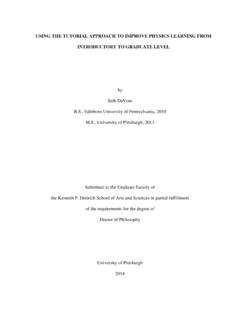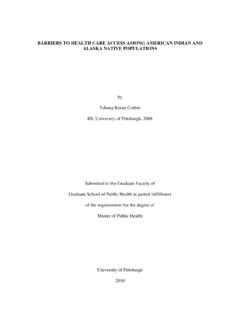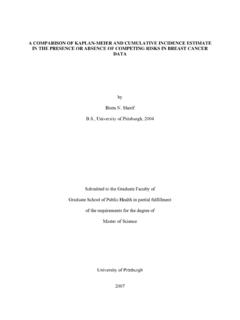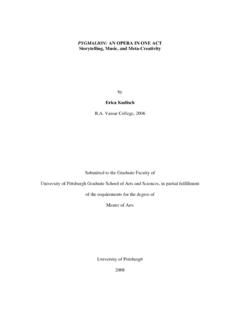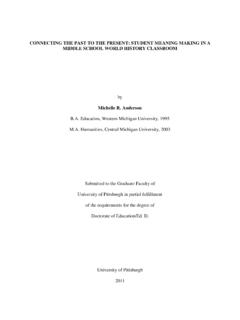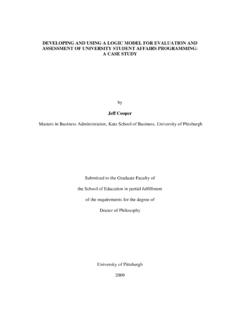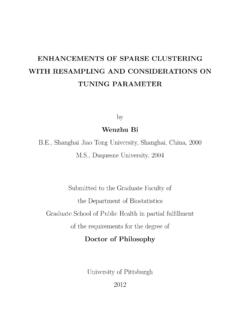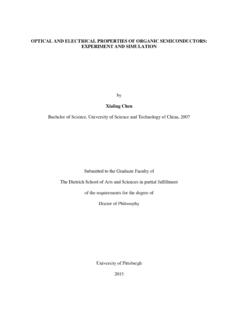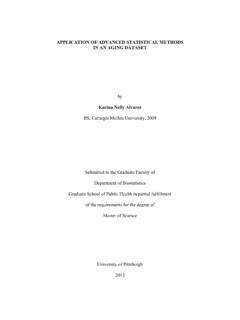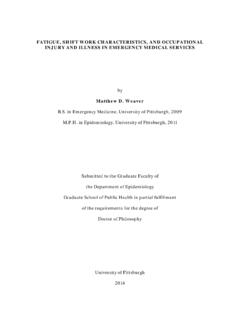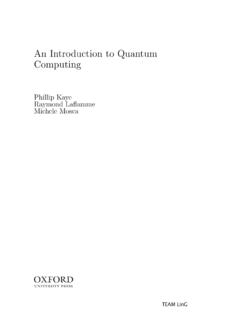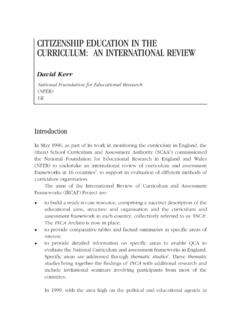Transcription of LEAN MANUFACTURING TOOLS AND TECHNIQUIS IN THE …
1 LEAN MANUFACTURING TOOLS AND TECHNIQUES IN THE PROCESS INDUSTRY. WITH A FOCUS ON STEEL. by Fawaz Abdullah BS in Mechanical Engineering, University of South Carolina, 1996. MS in Industrial Engineering, University of Pittsburgh, 1999. Submitted to the Graduate Faculty of School of Engineering in partial fulfillment of the requirements for the degree of Doctor of Philosophy University of Pittsburgh 2003. UNIVERSITY OF PITTSBURGH. SCHOOL OF ENGINEERING. This dissertation was presented by Fawaz Abdullah It was defended on May 13, 2003. and approved by Kim LaScola Needy, Associate Professor, Department of Industrial Engineering Bopaya Bidanda, Professor, Department of Industrial Engineering Harvey Wolfe, Professor, Department of Industrial Engineering Hegde, Associate Professor, Katz Graduate School of Business Dissertation Director: Jayant Rajgopal, Associate Professor, Department of Industrial Engineering ii Copyright, Fawaz Abdullah 2003.
2 Iii ABSTRACT. LEAN MANUFACTURING TOOLS AND TECHNIQUES IN THE PROCESS INDUSTRY. WITH A FOCUS ON STEEL. Fawaz Abdullah, PhD. University of Pittsburgh, 2003. This research addresses the application of lean MANUFACTURING concepts to the continuous production/ process sector with a focus on the steel industry. The goal of this research is to investigate how lean MANUFACTURING TOOLS can be adapted from the discrete to the continuous MANUFACTURING environment, and to evaluate their benefits on a specific application instance. Although the process and discrete industry share several common characteristics, there are areas where they are very different. Both MANUFACTURING settings have overlap, but at the extreme, each has its unique characteristics. This research attempts to identify commonalities between discrete and continuous MANUFACTURING where lean techniques from the discrete side are directly applicable.
3 The ideas are tested on a large steel MANUFACTURING company (referred to as ABS). Value stream mapping is used to first map the current state and then used to identify sources of waste and to identify lean TOOLS to try to eliminate this waste. The future state map is then developed for a system with lean TOOLS applied to it. To quantify the benefits gained from using lean TOOLS and techniques in the value stream mapping, a detailed simulation model is developed for ABS and a designed experiment is used to analyze the outputs of the simulation model for different lean configurations. Generalizations of the results are also provided. iv ACKNOWLEDGMENTS. I would like to thank Allah my lord for giving me the strength, patience, and guidance to go through this research. I wish also to thank my country Kuwait and the University of Pittsburgh for giving me the opportunity to pursue my degree in higher education.
4 I wish to express my genuine appreciation to my advisor, Dr. Rajgopal for his unlimited support, direction, advice, and patience with me during the preparation for this dissertation. I am very thankful to all my committee members Dr. Needy, Dr. Bidanda, Dr. Wolfe, and Dr. Hegde for their valuable comments and suggestion. I wish also to thank Dr. Needy for her guidance during this research. I would like to thank Mr. Bob Oster and Mr. Mark Lesnick for their assistance in collecting the data used in this research. I also would like to thank my wife Abrar for the invaluable support and patience during the course of this work. My thanks also go to my beloved son Abdullah for his good manners. I. also would like to thank my parents for their moral support; without them I would not be where I. am right now. v TABLE OF CONTENTS. INTRODUCTION ..1. 1. Problem 2. Research Objective .. 3. Research 4. BACKGROUND AND LITERATURE REVIEW.
5 5. The History of 5. What Is Lean?.. 6. Lean MANUFACTURING TOOLS and Techniques .. 10. Cellular MANUFACTURING .. 10. Continuous 11. Just-In-Time .. 13. Just-In-Time Production..14. Just-In-Time Just-In-Time Purchasing..18. Production 19. Standardization of Work .. 19. Total Productive Maintenance .. 20. Other Waste Reduction 21. vi From Lean MANUFACTURING to Lean Enterprise .. 22. Overview of Supply Chain Management .. 25. Customer 26. Supplier 27. Level of Manufacturer Integration .. 29. Discrete vs. Continuous MANUFACTURING 30. Application of Lean In Discrete 34. Continuous Process Industry and Lean .. 35. Value Stream 38. Simulation and Value Stream Mapping .. 43. 45. A TAXONOMY OF THE PROCESS A Common 47. Process Industry 48. Product 49. Material flow Characteristics .. 53. When do Nondiscrete Units Become Discrete in the Process?.. 56. Opportunities for Lean .. 59. OVERVIEW OF THE METHODOLOGY.
6 64. Overview of the Steelmaking Process .. 65. A Brief Survey of the Steel Industry .. 68. VALUE STREAM MAPPING AT vii Description of ABS .. 71. Value Stream Mapping: Current State Map .. 75. Value Stream Mapping: Future State Map .. 81. Takt Time .. 82. Finished Goods Supermarket .. 83. Pull System Supermarket .. 84. Continuous Flow .. 87. The Pacemaker .. 89. Production Leveling .. 90. The Pitch .. 93. Process Improvement .. 96. Setup 96. TPM .. 99. 102. THE SIMULATION Simulation Verification and Validation and Transient Period .. 108. SIMULATION IN SUPPORT OF VALUE STREAM MAPPING ..115. Production 116. TPM .. 118. Setup 122. Lead-Time Performance .. 123. Inventory Performance .. 128. 134. viii The Future State Map Revisited .. 136. OTHER LEAN TOOLS : 5S AND VISUAL SYSTEMS ..138. 5S .. 138. Visual Systems .. 145. 146. SUMMARY AND CONCLUSIONS ..149. Summary of the 149. Conclusions .. 151. Research Contributions and Future 155.
7 APPENDIX A (SURVEY) ..159. APPENDIX B (SIMULATION MODEL) ..164. ix LIST OF TABLES. Table 1 Industries sets and types of products .. 48. Table 2 Summary of the survey data .. 70. Table 3 Summary of the data in the current state map for ABS .. 77. Table 4 Due date calculation for the annealed products .. 92. Table 5 Number of kanbans required by product .. 93. Table 6 Number of pitches for every 94. Table 7 The time interval required for every product to withdraw per shift .. 95. Table 8 changeover times required at different processes at ABS .. 97. Table 9 Maintenance time for hot end at ABS .. 99. Table 10 Failures time distributions at 100. Table 11 Estimated process time distributions for ABS 104. Table 12 Product types for each 107. Table 13 Performance measures for Actual vs. 111. Table 14 Proposed TPM times at hot 122. Table 15 Proposed TPM times at finishing mill .. 122. Table 16 Proposed setup reduction times at 123.
8 Table 17 Data for average lead-time (in days) for the factorial 124. Table 18 Estimated Effects and Coefficients for 125. Table 19 Analysis of Variance for 125. x Table 20 Data for average WIP Inventory (number of coils) for the factorial designs .. 129. Table 21 Estimated Effects and Coefficients for WIP inventory .. 129. Table 22 Analysis of Variance for WIP inventory .. 130. Table 23 Estimated Effects and Coefficients for WIP inventory production system is 133. Table 24 Analysis of Variance for WIP inventory production system is 134. Table 25 Dock requirements at shipping warehouse .. 138. Table 26 5S Audit Checklist (Based on Sweeny, 2003).. 144. Table 27 Assessment of lean TOOLS in the steel industry .. 155. xi LIST OF FIGURES. Figure 1 Withdrawal Kanban (Source: Monden, Y., Toyota Production System-An Integrated Approach to Just-in-time, 1998).. 15. Figure 2 Production Kanban (Source: Monden, Y.)
9 , Toyota Production System-An Integrated Approach to Just-in-time, 1998).. 15. Figure 3 A classification of production plants (Source: B. Bidanda and R. E. Billo, presentation to Fleet Maintenance Facility-Cape Breton, February 1997.) .. 32. Figure 4 Icon used for value stream mapping (source: M. Rother and J. Shook, 1999) .. 41. Figure 5 Classification of the process industry based on raw material variety .. 51. Figure 6 Classification of the process industries based on product volume .. 52. Figure 7 Classification of the process industries with respect to equipment arrangement and 56. Figure 8 Classification of process industries based upon transformation into discrete units.. 59. Figure 9 General guidelines for applying lean TOOLS in the process industry: product 62. Figure 10 General guidelines for applying lean TOOLS in the process industry: material flow 63. Figure 11 Steelmaking process (source: ).
10 67. Figure 12 Coil movement through the MANUFACTURING process at the finishing mill.. 74. Figure 13 Current state 80. Figure 14 Finishing mill cycle time .. 88. Figure 15 The heijunka box (load leveling box) for ABS .. 94. Figure 16 SIMAN Model File for the LMF Process Module .. 109. xii Figure 17 SIMAN Experiment File for the 109. Figure 18 Transient period analysis for the average WIP inventory for 5 112. Figure 19 Transient period analysis for the average WIP ahead of HSM for 5 113. Figure 20 Transient period analysis for the average entity time in system for 5 replications .. 114. Figure 21 Normal probability plot of 126. Figure 22 Plot of residuals versus 127. Figure 23 Main effects plots for Average 127. Figure 24 Normal probability plot of 131. Figure 25 Plot of residuals versus 131. Figure 26 Main effect and interaction plot for inventory .. 132. Figure27 Future State Map.. 137. Figure 28 Example of a red 140.
